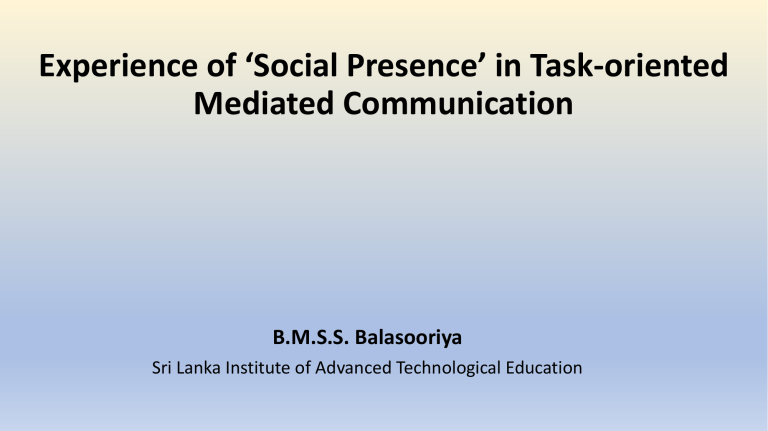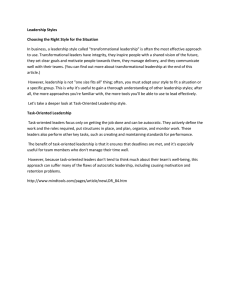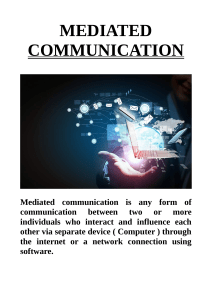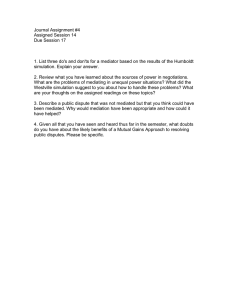
Experience of ‘Social Presence’ in Task-oriented Mediated Communication B.M.S.S. Balasooriya Sri Lanka Institute of Advanced Technological Education Introduction This study is about how social presence is experienced by the members of a group via mediated communication in a task-oriented environment. Conceptual Background ‘Social presence’ indicates the degree to which one is perceived as a real person in mediated communication. Definition: “the degree of feeling, perception, and reaction of being connected by CMC to another intellectual entity through a text-based encounter” Tu and McIsaac (2002) 4 social presence measurements: Personalimpersonal, Sensitive-insensitive, Warm-cold, Sociable-unsociable. (Short, 1976) A medium with a high degree of social presence -sociable, warm, and personal A medium with a low degree of social presence - less personal ‘CMC’: communication between two or more individuals that occurs via computer networks. It can be text, audio, graphics, or video based and it occurs synchronously or asynchronously. Synchronous: communication which occurs simultaneously in real time. E.g. video chats, audio calls, audio/video conferences, shared whiteboard Asynchronous: communication which takes place when the parties engaged are not communicating in unison. Immediate response is not produced by the receiver. E.g. emails, discussion forums, text massages, massages via social media Problem • During a time of social distancing, it is a challenge for the teachers to generate the feeling of social presence among the students. As physical contact is not possible, it is difficult to maintain interaction and create discussion effectively among them. • The difficulty gets worse when the students work towards a common learning achievement in groups. Objectives Main objective To investigate if students can experience social presence in online taskbased activity by using mediated communication. Specific Objectives • To examine how social presence is experienced in a CMC environment. • To identify the challenges in fostering social presence among the participants of remote collaborative group. • To identify the opportunities available for enhancing social presence. Methodology Case study Methodology Sampling Technique – Purposive Participants - 14 HNDEn followers Data collection method Semi-structured interviews Process-Activity Forming groups Assigning task Setting goals Imposing communication requirements Findings Data analysis technique: Thematic analysis Themes Emerging Themes Interview transcripts Discourse generated by segments of students’ communication Emotional tie, comfort, privacy, acceptance, satisfaction, learning & retention, exposure, contribution Discussion Factors causing effective social presence • The use of asynchronous methods than synchronous methods • Approachability and online proximity of the teacher • Willingness to interact • The task-oriented environment that creates the need for the sense of accomplishment. Restraints for effective social presence • Lack of intimacy • Lack of the feeling of contribution • Attitudinal deterrents to the use of technology Conclusion & Recommendations A task-oriented, mediated environment can provide an opportunity for teachers to improve the learning experiences of students during social distancing. The challenge of generating effective interaction among the members of a remote study group can be successfully faced by, • building a task-oriented environment with prior-set goals to be achieved. • using asynchronous communication methods frequently. • maintaining interaction through easy accessibility. References • Calefato, F. , Lanubile, F. (2010). Advances in Computers: Improving the Web in Advances in Computers. • Caspi, A., Blau, I. (2008). Social presence in online discussion groups: Testing three conceptions and their relations to perceived learning. Social Psychology of Education · DOI: 10.1007/s11218-0089054-2 • Chih-Hsiung, T. (2002). The Measurement of Social Presence in an Online Learning Environment. International Journal on E-learning. USA. • iSALT Team, "Social Presence Theory" (2014). iSALT Resources: Theories, Concepts, and Measures. Paper 2. • Kear, Karen (2010). Social presence in online learning communities. In: Proceedings of the 7th International Conference on Networked Learning 2010, 3-4 May 2010, Aalborg, Denmark. • Lowenthal, P. R. (2009). The Evolution and Influence of Social Presence Theory on Online Learning. To appear in T. T. Kidd (Ed.), Online education and adult learning: New frontiers for teaching practices (pp. 124-139). Hershey, PA: IGI Global. • Lowenthal, P. R., & Vanessa P. Dennen (2017) Social presence, identity, and online learning: research development and needs, Distance Education, 38:2, 137-140, DOI: 10.1080/01587919.2017.1335172 • McQuail, Denis. (2005). Mcquail's Mass Communication Theory. 5th ed. London: SAGE Publications.




